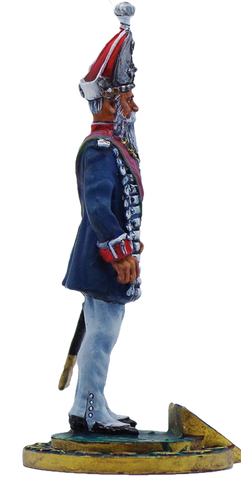
Georg II
Duke of Saxe-Meiningen
George II, Duke of Saxe-Meiningen (2 April 1826 – 25 June 1914), was the penultimate Duke of Saxe-Meiningen, reigning from 1866 to 1914. For his support for his successful court theatre he was also known as the Theaterherzog (theatre duke). George was the only son of Bernhard II, Duke of Saxe-Meiningen and his wife Princess Marie Frederica of Hesse-Kassel. His birth on 2 April 1826 was met with great relief as the succession to the duchy was in jeopardy due to a lack of male heirs in the family. George remained an only child for seventeen years, until the birth of his sister Princess Augusta in 1843. George spent his first few years under the supervision of his parents and grandmother the Dowager Duchess Luise Eleonore. It was the latter who instilled upon Georg the patriotic virtues of his heritage, as well as the sense of duty needed to rule a duchy. George succeeded his father as Duke of Saxe-Meiningen on 20 September 1866, when Bernhard was forced to abdicate in favor of his son following the defeat of Austria in the Austro-Prussian War. In opposition to his father, George had sided with the Prussians during the war and was rewarded with a position of Lieutenant General of the Prussian army. The young duke was familiar enough with Prussian politics to regard their attitudes as impractical. During the Franco-Prussian War, George led two regiments of soldiers from

Meiningen and had the honor of capturing the first French flags at the Battle of Froeschweiler. Notably, he fought in nearly every battle during the war. Georg was a member of Wilhelm I's staff when he entered Paris and remained a friend of the Emperor until the latter's death in 1888. After the Franco-Prussian War, George devoted himself to theatre. He was one of the greatest intellectuals among the higher nobility during the German Empire. He is particularly known for developing the Meiningen Ensemble using his court theatre. Using his knowledge of art history and his drawing skills, he designed highly detailed, historically accurate scenery, costumes, and properties. In addition, he choreographed large crowd scenes that stunned audiences across Europe. He and his ensemble toured Europe extensively, and had a profound effect on theatre production across the continent. The Duke was also the patron of one of Europe's leading orchestras, the Meiningen Court Orchestra. The orchestra attained its distinction after the Duke hired the conductor Hans von Bülow in 1880. In his later life, George suffered from acute deafness and retired from active life. He had been fond of hunting and traveling, and was a collector of antiques and manuscripts.

The Schlossgarde-Kompanie (also Schlossgardekompanie) was tasked with guarding the royal palaces and gardens in Prussia until 1918. On ceremonial occasions she wore high grenadier caps from the 18th century. The castle guard company consisted of semi-invalid infantry non-commissioned officers who had served for at least twelve years. Participation in military campaigns was desirable; military awards were an absolute requirement. The troops were all drawn from Prussia. Command initially rested with a lieutenant sergeant and later with a wing adjutant. The company numbered two sergeants, five sergeants and 62 non-commissioned officers. After 25 years of service, the non-commissioned officers received the portepee and a sword with a crown and were therefore called crown guards. The castle guard company was founded on March 30, 1829 as a guard non-commissioned officer company and renamed on October 3, 1861.

Saxe-Meiningen (German: Sachsen-Meiningen) was one of the Saxon duchies held by the Ernestine line of the House of Wettin, located in the southwest of the present-day German state of Thuringia. Established in 1681, by partition of the Ernestine Duchy of Saxe-Gotha among the seven sons of deceased Duke Ernest the Pious, the Saxe-Meiningen line of the House of Wettin lasted until the end of the German monarchies in 1918. The Wettiner had been the rulers of sizeable holdings in today's states of Saxony, Saxony-Anhalt and Thuringia since the Middle Ages. In the Leipziger Teilung of 1485, the Wettiner were split into two branches named after their founding princes Albrecht and Ernst (albertinisch and ernestinisch). Thuringia was part of the Ernestine holdings of Kursachsen (the Electorate of Saxony). In 1572, the branches Saxe-Coburg-Eisenach and Saxe-Weimar were established there. The senior line again split in 1641/41 into three duchies, including the Duchy of Saxe-Gotha. Duke Ernst I who founded this duchy with its seat at Gotha opposed the system of primogeniture. As a result, on his death in 1675 all of his sons inherited part of his holdings and were supposed to rule under the leadership of his oldest son. In practice, this proved very complicated and brought on three settlements in 1679, 1680 and 1681 that established the following princedoms: Saxe-Gotha (Friedrich), Saxe-Coburg
(Albrecht), Saxe-Meiningen (Bernhard), Saxe-Eisenberg (Christian), Saxe-Hildburghausen (Ernst) and Saxe-Saalfeld (Johann Ernst). Bernhard, Ernst I's third son, received the town of Meiningen as well as several other holdings (Wasungen und Salzungen, Maßfeld und Sand, Herrenbreitungen, Herpf, Stepfershausen, Utendorf, Mehlis and the former Franconian lands of the extinct House of Henneberg, Henneberg). Bernhard chose the town of Meiningen as his residence and became the first duke of Saxe-Meiningen. From 1682 Duke Bernhard I had the Schloss Elisabethenburg built and in 1690 established a court orchestra (Hofkapelle), in which Johann Ludwig Bach later became the Kapellmeister (1711). In the German Revolution after World War I, Duke Bernhard III, brother-in-law of Emperor Wilhelm II, was forced to abdicate and his brother Ernst on 11/12 November 1918 refused the succession.
Awards: Collar, sash and star of the Saxe-Ernestine House Order, Stars of the Order of the Black Eagle, the Order of the Rue Crown and the Order of the White Falcon.






